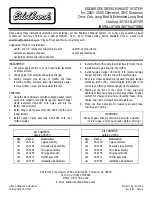
8
CONSUMER INFORMATION, REPORTING SAFETY DEFECTS & BINDING ARBITRATION OF WARRANTY CLAIMS
6
I030D01JM-AAT
TIRE TERMINOLOGY AND DEFINI-
TIONS
Air Pressure: The amount of air inside
the tire pressing outward on the tire. Air
pressure is expressed in pounds per
square inch (psi) or kilopascal (kPa).
Accessory Weight: This means the
combined weight of optional accesso-
ries. Some examples of optional ac-
cessories are, automatic transmission,
power seats, and air conditioning.
Aspect Ratio: The relationship of a
tire's height to its width.
Belt: A rubber coated layer of cords that
is located between the plies and the
tread. Cords may be made from steel or
other reinforcing materials.
Bead: The tire bead contains steel
wires wrapped by steel cords that hold
the tire onto the rim.
Bias Ply Tire: A pneumatic tire in which
the plies are laid at alternate angles
less than 90 degrees to the centerline of
the tread.
Cold Tire Pressure: The amount of air
pressure in a tire, measured in pounds
per square inch (psi) or kilopascals
(kPa) before a tire has built up heat from
driving.
Curb Weight: This means the weight of
a motor vehicle with standard and op-
tional equipment including the maxi-
mum capacity of fuel, oil and coolant,
but without passengers and cargo.
DOT Markings: A code molded into the
sidewall of a tire signifying that the tire
is in compliance with the U.S. Depart-
ment of Transportation motor vehicle
safety standards. The DOT code in-
cludes the Tire Identification Number
(TIN), an alphanumeric designator which
can also identify the tire manufacturer,
production plant, brand and date of
production.
GVWR: Gross Vehicle Weight Rating
GAWR FRT: Gross Axle Weight Rating
for the front Axle.
GAWR RR: Gross Axle Weight Rating
for the rear axle.
6. Maximum load rating
This number indicates the maximum
load in kilograms and pounds that
can be carried by the tire. When
replacing the tires on the vehicle,
always use a tire that has the same
load rating as the factory installed
tire.
7. Uniform Tire Quality Grading
(UTQG):
Tire manufacturers are required to
grade tires based on three perfor-
mance factors: treadwear, traction
and temperature resistance. For more
information, see Uniform Tire Qual-
ity Grading on page 8-12.
jmhma-8-1.p65
10/5/04, 11:19 AM
6
Summary of Contents for Tucson 2005
Page 1: ...9 24 04 10 10 AM...
Page 3: ...10 10 INDEX 9 24 04 10 10 AM...
Page 9: ...9 9 2 9 3 9 4 9 CLE SPECIFICATIONS 9 24 04 9 56 AM...
Page 28: ...7 stem 7 2 7 3 7 ON CONTROL SYSTEMS 9 24 04 9 57 AM...
Page 63: ...6 DO IT YOURSELFMAINTENANCE 33 9 24 04 10 00 AM...
Page 66: ...G200E01JM 9 24 04 10 00 AM...
Page 78: ...4 n 4 2 rrosion 4 2 g 4 3 4 5 4 VENTION APPEARANCE CARE 9 24 04 10 01 AM...
Page 98: ...3 WHATTODOINANEMERGENCY 15 9 24 04 10 02 AM...
Page 138: ...1 FEATURESOFYOURHYUNDAI 93 9 24 04 10 04 AM...
Page 153: ...9 24 04 10 05 AM...
Page 159: ...9 24 04 10 05 AM...
Page 163: ...9 24 04 10 05 AM...
Page 166: ...1 FEATURESOFYOURHYUNDAI 121 9 24 04 10 05 AM...
Page 176: ...1 FEATURESOFYOURHYUNDAI 131 9 24 04 10 05 AM...
Page 188: ...UMENTSANDCONTROLS B250A01JM U 9 24 04 10 10 AM...
Page 232: ...S B260A01JM U 9 24 04 10 07 AM...
















































